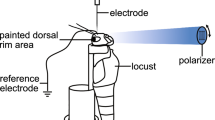Summary
Water bugs (Notonecta glauca) were set into flight in a room with a homogeneously illuminated ceiling and a light-emitting platform on the floor. In these conditions polarized UV light from the platform was more effective in causing the animals to fly down to the surface of the platform than was unpolarized UV light several times as intense. Experiments with an array of baffles that restricted the directions from which the polarization film on the platform could be seen showed that the polarized UV light is effective in eliciting descent only when the e-vector is perpendicular to the median sagittal plane of the animal (horizontal). It can be concluded that polarized UV light with horizontal e-vector is distinguished, as a special sensory quality, from unpolarized UV light.Notonecta thus provides an example of true polarization vision.
The special orthogonal arrangement of the microvilli in the rhabdomeres of the UV visual cells in the ventral part of the eye (cf. Schwind 1983 b and Schwind et al., in press) is suggestive with regard to polarization vision. The microvilli of the two UV visual cells in the ommatidia looking forward and down are horizontal and vertical, respectively, and hence could serve as a two-channel analyzer system capable of distinguishing the polarized UV light reflected by a water surface from unpolarized UV light.
Similar content being viewed by others
References
Autrum H, Stumpf H (1950) Das Bienenauge als Analysator für polarisiertes Licht. Z Naturforsch 5b: 116–122
Bernard GD, Wehner R (1977) Functional similarities between polarization vision and color vision. Vision Res 17:1019–1028
Burkhardt D, Wendler L (1960) Ein direkter Beweis für die Fähigkeit einzelner Sehzellen des Insektenauges, die Schwingungsrichtung polarisierten Lichtes zu analysieren. Z Vergl Physiol 43: 687–694
Frisch K von (1949) Die Polarisation des Himmelslichtes als orientierender Faktor bei den Tänzen der Bienen. Experientia 5:142–148
Kirschfeld K (1972) Die notwendige Anzahl von Rezeptoren zur Bestimmung der Richtung des elektrischen Vektors linear polarisierten Lichtes. Z Naturforsch 17b: 578–579
Kirschfeld K (1973) Vision of polarized light. Int Biophys Congr Moscow 4:289–296
Laughlin SB (1976) The sensitivities of dragonfly photoreceptors and the voltage gain of transduction. J Comp Physiol 111:221–241
Schwind R (1983a) A polarization-sensitive response of the flying water bugNotonecta glauca to UV light. J Comp Physiol 150:87–91
Schwind R (1983b) Zonation of the optical environment and zonation in rhabdom structure within the eye of the backswimmerNotonecta glauca. Cell Tissue Res 232:53–63
Schwind R, Schlecht P, Langer H (1984) Microspectrophotometric characterization and localization of three visual pigments in the compound eye ofNotonecta glauca L. (Heteroptera). J Comp Physiol (in press)
Waterman TH (1981) Polarization sensitivity. In: Autrum H (ed) Handbook of sensory physiology, vol VII/6B. Springer, Berlin Heidelberg New York, pp 281–469
Author information
Authors and Affiliations
Rights and permissions
About this article
Cite this article
Schwind, R. Evidence for true polarization vision based on a two-channel analyzer system in the eye of the water bug,Notonecta glauca . J. Comp. Physiol. 154, 53–57 (1984). https://doi.org/10.1007/BF00605390
Accepted:
Issue Date:
DOI: https://doi.org/10.1007/BF00605390



